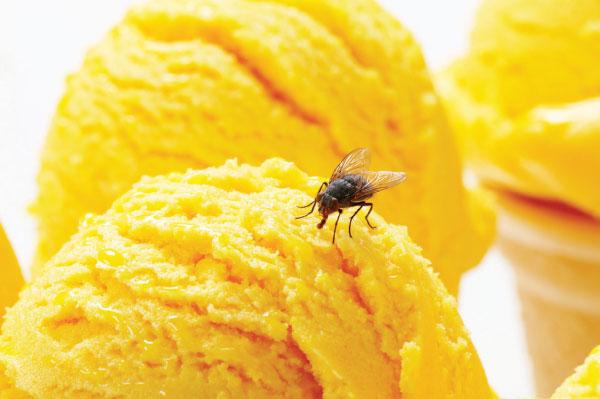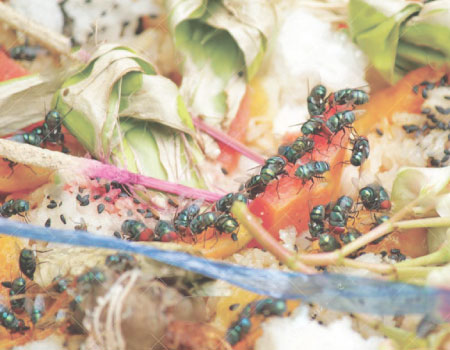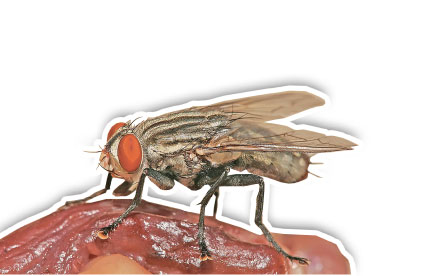
Virtually everyone in the world has at some time, been disturbed by the housefly. They are at home in all homes, be it in Colombo 7 or the canvas covered luxury homes of the homeless living on the pavement. They are also at all places of religious worship and in ships at sea.
The housefly is one of the 100,000 species of flies and is the most detestable and disease carrying insect in the world apart from the mosquito.
The fly is very light, and about 150,000 would weigh around a kilogramme. It looks frightening with short stubby hairs and full circle rotating head with large eyes that give unfocussed sight. His image of the world is of light, dark and movement.
Its antennae has sense cells that can detect movement in the air, apparent dangers like hands and fly –swatters. It could also smell rotting garbage and other fly delicacies, in fact, all odours. Its mouth is called the proboscis and looks like a funnel. Its body can be retracted when not in use and is pressed into its source of food. Its tiny teeth can scrape all the particles of food, through a suction pad called the labella.
As all other insects, it has six legs, used for walking and tasting. Sugar and protein laced food are its favourites. The female feeds less on sugar and more on protein, during its egg laying season. Its food has to be spongy and made liquid. It would spit on anything to make it juicy and delectable.
Next, the proboscis sucks the food like a vacuum cleaner. A bit of vomit remains where it had it raja bojun. These telltale marks could be seen on clean windows, amounting to a couple of thousands to a square inch.
Flies just hang around on four of their legs. Man has wondered at their mobility. They can land anywhere. They can walk up walls, rest on leaves, sambol, ambulthial, custard pudding and chutney within seconds. Equally wondrous is their ability to take off and land without a runway.
The fly needs a little jump or glider before a start and a stop. It is airborne as soon as it beats its wings. Its wings are fascinating. They are paper thin, multi-veined and could keep on beating for hours at an unbelievable rate of about 200 times a second and are replenished by four auxiliary hearts, to keep the wing muscles in working order. These muscles weigh about 15 per cent of its total body weight.
Flies are prolific breeders. A new generation arrives every 10 days. The female lays about 120 eggs at a sitting. Scientists have calculated that a single pair of flies could produce, say between April and December a progeny to cover four times the size of our country, up to a depth or thickness of about 10 metres. But nature has made this awesome happenning to be contained through lizards, frogs, snakes, birds, rats and man.
 Once hatched, flies live three lives. In the maggot stage they look like worms. They eat and grow while shedding their skins many a time. Next, they builds cases round their bodies and in the pupal stage. Then they burst out of the shell as adult flies.
Once hatched, flies live three lives. In the maggot stage they look like worms. They eat and grow while shedding their skins many a time. Next, they builds cases round their bodies and in the pupal stage. Then they burst out of the shell as adult flies.
A housefly’s life is ruled by temperature. It becomes lethargic when temperature drops. High temperature causes paralysis and sometimes death. Very cold weather could also be fatal. They live about 30 days.
The housefly has been with us for ages. It has graced our mouth watering delicacies, puss oozing sores, the nappies of babes and bodies of humans and animals. They are in maternity homes and funeral parlours. What makes us to hate them is because they can be on our lunch table and any other place within a few seconds, leaving a new generation, their spit and their vomit. Shop windows in hotels and market places have millions of these marks.
They carry the germs for dysentery, cholera, tuberculosis and many other infectious diseases. Millions have died.
Many have become benevolent millionaires, in giving us state of the art fly swatters and sprays. We will never be able to eliminate the housefly. But we can keep them away by keeping food and garbage in containers and keep the environment clean.
The housefly has been, is and will be a part of nature for all time.
